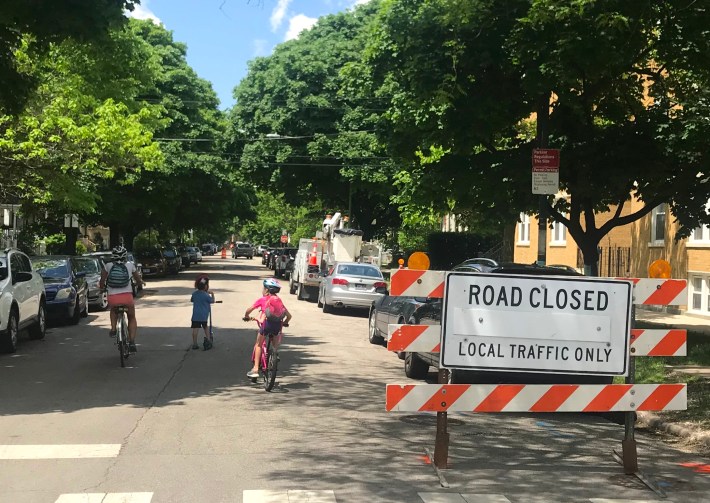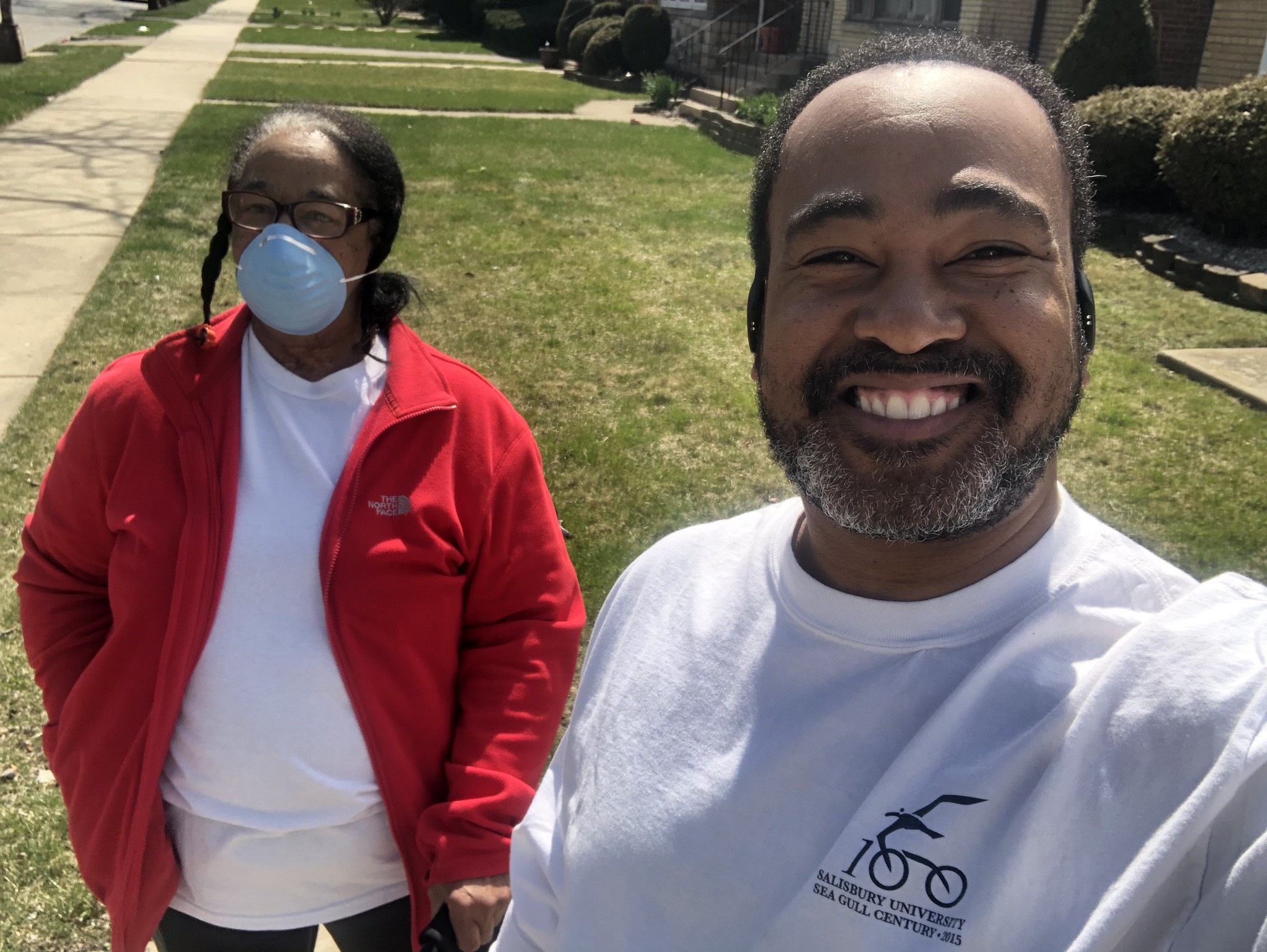[A version of this article ran in the Chicago Reader in late April. Since then a Slow Street has opened on Leland Avenue in the 47th Ward, and several more are proposed. Palmer Street between Long Avenue and Kedzie Boulevard will likely be one of the next ones to open.]
South Shore senior Josie Conley takes walks regularly to stay healthy during the COVID-19 quarantine. But narrow sidewalks mean that maintaining the recommended six-foot "social distance" from others is sort of like a game of Dodge 'Em. "My mother doesn't want to take any chances," explained her son Shawn Conley, who joins her on the excursions during his lunch break from his job with the Illinois State Board of Education. Shawn also helps lead the Major Taylor Cycling Club of Chicago, a predominantly Black organization with about 120 members.
Josie won't leave the house unless the sidewalk is clear for half a block in front of her, and once an approaching pedestrian is six or eight houses away, she detours onto the driveway or lawn of an adjacent home to get out of the way. Shawn said other elderly people in the neighborhood use the same approach, ducking out of the way if they see younger people heading towards them to avoid respiratory droplets.
During non-pandemic times, many local seniors, as well as younger joggers, head to the track at Eckersall Park, 83rd and Yates, for exercise. But like many parks across Chicago that were temporarily or permanently closed during the pandemic due to concerns about social distancing infractions, like congregating, team sports, and playground use, it has been off-limits. So people have been walking and jogging on sidewalks around the perimeter of the park, which creates its own crowding problems.
Pedestrians jockeying for space in the time of coronavirus seems to be an issue in many of Chicago's denser neighborhoods. That's been especially true since March 26, when Mayor Lori Lightfoot closed all lakefront parks, including the Lakefront Trail, as well as the Chicago Riverwalk and The 606 elevated greenway, in response to path congestion and violations of Illinois' Stay at Home order guidelines on the first warm day of spring.
On any nice evening it's common to see dozens of people running and walking in the street on Inner Lake Shore, the nearest surface road to the Lakefront, in Lincoln Park and Lakeview, in order to avoid congestion on skinny sidewalks. Even though car traffic is down about 50 percent nowadays while many people are working from home or laid off, that's not a great idea, since Inner LSD is a busy bus corridor, and many motorists are taking advantage of empty Chicago streets to drive dangerously fast.
On the other hand, Lincoln Park alderman Michele Smith told the Tribune that “hundreds” of constituents have complained to her about being buzzed by joggers while walking on local sidewalks during the pandemic. Crowding among pedestrians and cyclists has also been an issue on recreational paths that remain open, such as the North Branch and North Shore Channel trails.
Some might respond to this dilemma with the ubiquitous "Stay home!" mantra, arguing people shouldn't be leaving the house during COVID-19 anyway, except to commute to essential jobs and pick up supplies. But the Illinois Stay at Home order acknowledges that "walking, hiking, running, or biking" are "essential activities," key for maintaining physical and mental wellness during this stressful time.
Clearly Chicago needs to make accommodations for safe walking and biking during COVID-19. Cities all over the country and the world are currently doing so, seizing this unique moment in modern history when automobile use has plummeted to reallocate roadway space. New York, Philadelphia, Washington, D.C., Boston, Madison, the Twin Cities, Denver, and Portland have all been temporarily banning or restricting cars on stretches of road to drivers to allow folks on foot and bikes to safely travel and get physical activity. Some of them, like NYC, are also turning lightly-used travel and parking lanes into emergency bike lanes to reduce dangerous crowding on transit, as are global metropolises like Bogotá, Mexico City, Paris, and Berlin.
In April, Oakland, California, announced plans for "Slow Streets," a clever approach to opening roadways that addresses most of those concerns. The Bay Area city, about a sixth the population of Chicago, with similar racial demographics, is creating a 74-mile network of side streets where people can safely walk, run, and bike in the road. Through traffic is banned, which is a non-issue for drivers right now since there's no congestion on arterials, but residents, visitors, first responders, and delivery personnel can still access local destinations. Parking, deliveries, and pickups and drop-offs are allowed.
According to the city of Oakland, the program was designed with a focus on racial and economic equity. In a statement, officials noted that "Oaklanders have inequitable access to parks and open space, and the lack of safe space to be active [during the pandemic] further exacerbates existing equity issues... [Slow Streets] seeks to reduce barriers to opportunities for physical activity and ensure safe transportation for our most vulnerable community members." In an April interview with Streetsblog USA, Warren Logan, who directs mobility policy for Mayor Libby Schaaf, stressed that a major goal was to make it easier for low-income people without cars to do essential trips at a time when transit service is reduced.

The Slow Streets idea has caught on in several other cities since then, such as San Francisco, where Mayor London Breed announced that 12 side streets would be closed to through traffic. “While traffic congestion has dropped, it is still difficult for people to maintain physical distance on many sidewalks... This program will help people keep six feet of distance from others.”
In April, the Active Transportation Alliance indicated that it wouldn't be advocating for opening streets to walking and biking during the pandemic. One reason the advocacy group state was, "In conversations with community partners serving Latinx, Black, and Asian communities, nobody pointed to open streets as an immediate need." (ATA later reversed their position and began talking to elected officials about open streets and Slow Streets.)
The advocacy group wouldn't tell us which community partners they spoke with. So to get feedback on whether an Oakland-style program, at low cost, allowing local motor vehicle access, and with no new policing, might be beneficial in neighborhoods of color during the pandemic, in April we reached out to dozens of community organizations, aldermen, and transportation leaders in diverse neighborhoods. Here's who we heard back from.
Christian Diaz, lead housing organizer with the Logan Square Neighborhood Association, said he likes the concept in theory, but argued now is not the time. "Open streets with culturally relevant programming could increase the quality of life for many here if done right," he said, but added that many residents were currently having trouble paying for food or rent. "While [it's] by no means a terrible idea I don't have reason to believe this is a priority right now for people who are hungry and at risk of homelessness."
Derek Lau, program assistant for the Coalition for a Better Chinese American Community, said he was worried about open streets encouraging congregation. "A program that could potentially attract a large crowd of people is dangerous." After we clarified that the Oakland Slow Streets will be spread over dozens of miles, CBCAC executive director Grace Chan McKibben said the organization would be interested in watching whether that strategy is successful and could possibly be adapted elsewhere.
Torrey Barrett, CEO of the Washington Park-based KLEO Community Family Life Center, said Slow Streets is a good idea for areas that lack recreational amenities. "Downtown and the North Side have walking and biking paths," he said. "On the South and West sides, not so much." But he'd like the program to be combined with additional benefits for low-income residents, such having the city provide funding to purchase bikes for residents, and partnering with the Greater Food Depository to distribute meals on the streets.
Democratic Socialist Northwest Side alderman Carlos Ramirez-Rosa, said he was in favor of trying Slow Streets. "We agree that the pilot programs being rolled out in other cities should be done here in Chicago in order to provide opportunities for people to safely walk, run, and bike in the street while practicing safe social distancing," his office said in a statement. (Rosa is currently collecting input on whether he should approve the Palmer Slow Street.)
Jacky Grimshaw, vice president with the Center for Neighborhood Technology urban planning think tank, said Slow Streets would work well in dense parts of town with limited access to trails or green space. However, she said it would be important to educate residents about the no-through traffic rule.
Elihu Blanks, a banker and South Shore resident who regularly attends Chicago's quarterly Mayor's Bicycle Advisory Council meetings. He said he likes the Slow Streets concept, but doesn't trust drivers to comply with an unenforced ban on through traffic. "I don't think that would be appreciated or respected in much of the South Side, or much of the North Side."
Deloris Lucas leads the bike group We Keep You Rollin' in the Far South Riverdale community area. During the COVID-19 crisis, she's been offering loaner bikes to residents, sanitized between users, so they can "de-stress themselves" by taking a brief spin. While she doesn't think Slow Streets are needed in Riverdale, where side streets are fairly quiet, "I do think it's a great idea to have more spaces to ride during the pandemic."
As for South Shore resident Shawn Conley, he said being able to safely walk in the street would prevent his mother Josie from having to dodge other pedestrians. "It would help increase her level of comfort," he said. "I know we're supposed to be sheltering at home, but as it warms up, people are going to need to get exercise, fresh air, and Vitamin D. So the more I think about Slow Streets, the more I like it."




